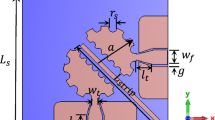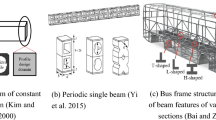Abstract
Spaceborne large aperture membrane microstrip reflectarray antenna has the characteristics of high gain, lightweight and small storage volume, which will be used in future space missions. However, there are two main reasons restricting its application. Firstly, the traditional dimensional optimization method cannot effectively affect the distribution of prestress in the membrane reflector, so it needs to increase too much mass to achieve the goal of stiffness improvement; secondly, low stiffness makes the membrane reflector more sensitive to various uncertainties. In view of this, this paper proposes a method to affect the distribution of prestress by sticking irregular shaped additional layer, and proposes a non-probabilistic uncertain topology optimization method to design the shape of additional layer. The effectiveness of the proposed methods is verified by numerical examples.














Similar content being viewed by others
References
Allaire G, Jouve F, Toader AM (2004) Structural optimization using sensitivity analysis and a level-set method. J Comput Phys 194:363–393
Alonso C, Ansola R, Querin OM (2014a) Topology synthesis of Multi-Input–Multi-Output compliant mechanisms. Adv Eng Softw 76:125–132
Alonso C, Ansola R, Querin OM (2014b) Topology synthesis of multi-material compliant mechanisms with a Sequential Element Rejection and Admission method. Finite Elem Anal Des 85:11–19
Anselmi N, Manica L, Rocca P, Massa A (2013) Tolerance analysis of antenna arrays through interval arithmetic. IEEE Trans Antennas Propag 61(11):5496–5507
Behrou R, Lotfi R, Carstensen JV, Ferrari F, Guest JK (2021) Revisiting element removal for density-based structural topology optimization with reintroduction by Heaviside projection. Comput Methods Appl Mech Eng 380(1):113799
Berry DG, Malech RG, Kennedy WA (1963) The reflectarray antenna. IEEE Trans Antennas Propag 11(6):646–651
Bialkowski ME, Robinson AW, Song HJ (2002) Design, development, and testing of X-band amplifying reflectarrays. IEEE Trans Antennas Propag 50(8):1065–1076
Chen N, Yu D, Xia B, Ma Z (2016) Topology optimization of structures with interval random parameters. Comput Methods Appl Mech Eng 307:300–315
Deng H, Li T, Wang Z (2015) Pretension design for space deployable mesh reflectors under multi-uncertainty. Acta Astronaut 115:270–276
Encinar JA, Arrebola M, De La Fuente LF, Toso G (2011) A transmit-receive reflectarray antenna for direct broadcast satellite applications. IEEE Trans Antennas Propag 59(9):3255–3264
Guo X, Zhang W, Zhang L (2013) Robust structural topology optimization considering boundary uncertainties. Comput Methods Appl Mech Eng 253:356–368
Guo X, Zhang W, Zhong W (2014a) Doing topology optimization explicitly and geometrically—a new moving morphable components based framework. J Appl Mech 81:081009
Guo X, Zhang W, Zhong W (2014b) Explicit feature control in structural topology optimization via level set method. Comput Methods Appl Mech Eng 272:354–378
Guo X, Zhou J, Zhang W, Du Z, Liu C, Liu Y (2017) Self-supporting structure design in additive manufacturing through explicit topology optimization. Comput Methods Appl Mech Eng 323:27–63
Hedgepeth JM (1982) Accuracy potentials for large space antenna reflectors with passive structure. J Spacecr Rockets 19(3):211–217
Hodges R, Zawadzki M (2004) Design of a large dual polarized Ku-band reflectarray for spaceborne radar altimeter. In: Proceedings of IEEE AP-S symposium, Monterey, USA, 2004
Hu N, Duan B, Xu W, Zhou J (2017) A new interval pattern analysis method of array antennas based on Taylor expansion. IEEE Trans Antennas Propag 65(11):6151–6156
Huang J (1994) Analysis of a microstrip reflectarray antenna for microspacecraft applications. TDA progress report, pp 153–173. http://ipnpr.jpl.nasa.gov/progress_report/42-120/120H.pdf
Huang J, Feria A (1999) Inflatable microstrip reflectarray antennas at X and Ka-band frequencies. In: Proceedings of the IEEE AP-S symposium, Orlando, USA, 1999
Jansen M, Lombaert G, Schevenels M (2015) Robust topology optimization of structures with imperfect geometry based on geometric nonlinear analysis. Comput Methods Appl Mech Eng 285:452–467
Jiu L, Zhang W, Meng L, Zhou Y, Chen L (2020) A CAD-oriented structural topology optimization method. Comput Struct 239:106324
Kawamoto A, Matsumori T, Yamasaki S, Nomura T, Kondoh T, Nishiwaki S (2011) Heaviside projection based topology optimization by a PDE-filtered scalar function. Struct Multidisc Optim 44(1):19–24
Kim JW, Kim BS, Nam S, Lee CW (1996) Computation of the average power pattern of a reflector antenna with random surface errors and misalignment errors. IEEE Trans Antennas Propag 44(7):996–999
Kogiso N, Ahn W, Nishiwaki S, Izui K, Yoshimura M (2008) Robust topology optimization for compliant mechanisms considering uncertainty of applied loads. J Adv Mech Des Syst Manuf 2:96–107
Lee TH, Ruddock RC (1989) A surface distortion analysis applied to the hoop/column deployable mesh reflector antenna. IEEE Trans Antennas Propag 37(4):452–458
Liu J, Wen G, Xie YM (2015) Layout optimization of continuum structures considering the probabilistic and fuzzy directional uncertainty of applied loads based on the cloud model. Struct Multidisc Optim 53:1–20
Malagisi CS (1978) Microstrip disc element reflect array. In: Proceedings of the electronics and aerospace systems convention, Arlington, USA, 1978
Menzel W, Pilz D, Leberer R (1999) A 77-GHz Fm/CW radar front-end with a low-profile low-loss printed antenna. IEEE Trans Microw Theory Tech 47(12):2237–2241
Nayeri P, Yang F, Elsherbeni AZ (2018) Reflectarray antennas: theory, designs, and applications. Wiley, Hoboken
Norato JA, Bell BK, Tortorelli DA (2015) A geometry projection method for continuum-based topology optimization with discrete elements. Comput Methods Appl Mech Eng 293:306–327
Poli L, Manica L, Rocca P, Massa A (2014) An interval arithmetic-based robustness evaluation of subarrayed linear array antenna architectures. In: The 8th European conference on antennas and propagation (EuCAP 2014), 2014
Poli L, Rocca P, Anselmi N, Massa A (2015) Dealing with uncertainties on phase weighting of linear antenna arrays by means of interval-based tolerance analysis. IEEE Trans Antennas Propag 63(7):3229–3234
Profera CE (n.d.) Reflect array antenna for communication satellite frequency re-use applications. US Patent 5543809
Qiu Z (2005) Convex models and interval analysis method to predict the effect of uncertain-but-bounded parameters on the buckling of composite structures. Comput Methods Appl Mech Eng 194:2175–2189
Rahmat-Sammi Y (1983) An efficient computational method for characterizing the effects of random surface errors on the average power pattern of reflectors. IEEE Trans Antennas Propag 31(1):92–98
Richardson JN, Coelho RF, Adriaenssens S (2015) Robust topology optimization of truss structures with random loading and material properties: a multiobjective perspective. Comput Struct 154:41–47
Sigmund O (1997) On the design of compliant mechanisms using topology optimization. Mech Struct Mach 25:493–524
Sigmund O, Petersson J (1998) Numerical instabilities in topology optimization: a survey on procedures dealing with checkerboards, mesh-dependencies and local minima. Struct Optim 16(1):68–75
Wang MY, Wang X, Guo D (2003) A level set method for structural topology optimization. Comput Methods Appl Mech Eng 192:227–246
Wang L, Wang X, Li Y, Lin G, Qiu Z (2016) Structural time-dependent reliability assessment of the vibration active control system with unknown-but-bounded uncertainties. Struct Control Health Monit. https://doi.org/10.1002/stc.1965
Wang X, Geng X, Wang L, Wang R, Shi Q (2017) Motion error based robust topology optimization for compliant mechanisms under material dispersion and uncertain forces. Struct Multidisc Optim 57(6):2161–2175
Wang R, Zhang X, Zhu B (2019) Imposing minimum length scale in moving morphable component (MMC)-based topology optimization using an effective connection status (ECS) control method. Comput Methods Appl Mech Eng 351:667–693
Wang X, Luo Z, Geng X (2020) Experimental verification of robust topology optimization for compliant mechanism. Rapid Prototyp J 26(9):1485–1502
Wang C, Yuan S, Gao W, Jiang C, Yan Y, Zheng Y, Wang Z, Wang M, Song X (2021a) A prior knowledge-based algorithm for robust design of array antennas with interval excitation and position uncertainties. IEEE Trans Antennas Propag 69(3):1355–1368
Wang L, Li ZS, Ni BW, Gu KX (2021b) Non-probabilistic reliability-based topology optimization (NRBTO) scheme for continuum structures based on the parameterized level-set method and interval mathematics. Comput Methods Appl Mech Eng 373:113477
Wu J, Luo Z, Li H, Zhang N (2017) Level-set topology optimization for mechanical metamaterials under hybrid uncertainties. Comput Methods Appl Mech Eng 319:414–441
Xie Y, Steven GP (1993) A simple evolutionary procedure for structural optimization. Comput Struct 49:885–896
Yaji K, Otomori M, Yamada T, Izui K, Nishiwaki S, Pironneau O (2016) Shape and topology optimization based on the convected level set method. Struct Multidisc Optim 54:1–14
Zhang W, Zhou J, Zhu Y, Guo X (2017a) Structural complexity control in topology optimization via moving morphable component (MMC) approach. Struct Multidisc Optim 56:1–18
Zhang W, Zhou J, Zhu Y, Guo X (2017b) Structural complexity control in topology optimization via moving morphable component (MMC) approach. Struct Multidisc Optim 56(3):535–552
Zhao ZL, Zhou S, Cai K, Xie Y (2020) A direct approach to controlling the topology in structural optimization. Comput Struct 227:106141
Zheng S, Fan H, Zhang Z, Tian Z, Jia K (2021) Accurate and real-time structural topology prediction driven by deep learning under moving morphable component-based framework. Appl Math Model 97:522–535
Zhou Y, Zhan H, Zhang W, Zhu J, Bai J, Wang Q, Gu Y (2020) A new data-driven topology optimization framework for structural optimization. Comput Struct 239:106310
Zhu B, Chen Q, Wang R, Zhang X (2018) Structural topology optimization using a moving morphable component-based method considering geometrical nonlinearity. J Mech Des 140(8):081403
Zong Y, Hu N, Duan B, Du J, Xu W, Yang G (2016) Robust design of cable-network antennas with imperfect cable lengths. J Aerosp Eng 29:04015
Acknowledgements
This work is supported by the National Nature Science Foundation of China with Nos. 52005494 and 12102444
Author information
Authors and Affiliations
Contributions
Author contributions
Yanben Han and Meng Li contributed to the work equally and should be regarded as co-first authors.
Corresponding author
Ethics declarations
Conflict of interest
The authors declare that they have no knowen competing financial interests or personal relationships that could apperared to influencce the work reported in this paper.
Replication of results
Code and data for replication can be provided up on request.
Additional information
Responsible Editor: Palaniappan Ramu
Publisher's Note
Springer Nature remains neutral with regard to jurisdictional claims in published maps and institutional affiliations.
Rights and permissions
Springer Nature or its licensor (e.g. a society or other partner) holds exclusive rights to this article under a publishing agreement with the author(s) or other rightsholder(s); author self-archiving of the accepted manuscript version of this article is solely governed by the terms of such publishing agreement and applicable law.
About this article
Cite this article
Han, Y., Li, M., Liu, Y. et al. Non-probabilistic uncertain design for spaceborne membrane microstrip reflectarray antenna by using topology optimization. Struct Multidisc Optim 66, 28 (2023). https://doi.org/10.1007/s00158-022-03416-5
Received:
Revised:
Accepted:
Published:
DOI: https://doi.org/10.1007/s00158-022-03416-5




